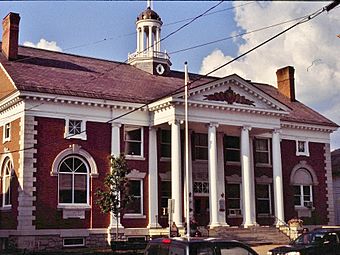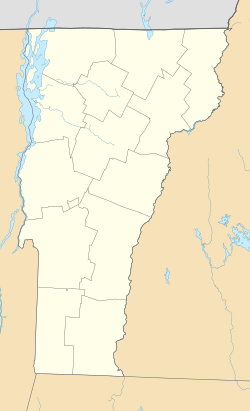Stowe Village Historic District facts for kids
Quick facts for kids |
|
|
Stowe Village Historic District
|
|

Stowe town hall
|
|
| Location | VT 100 and VT 108, Stowe, Vermont |
|---|---|
| Area | 153 acres (62 ha) |
| Architectural style | Greek Revival, Federal, Late Victorian |
| NRHP reference No. | 78000236 |
| Added to NRHP | November 15, 1978 |
The Stowe Village Historic District is a special area in the heart of Stowe, Vermont. It's like a time capsule, showing how the village grew into a popular vacation spot. This historic district was officially recognized and added to the National Register of Historic Places in 1978.
Contents
Exploring Stowe's Historic Village
The village of Stowe has been a major resort area in Vermont since the 1800s. Its buildings and streets tell the story of this history. Let's explore what makes this district so unique!
How Stowe Village Grew
Stowe was first settled in the early 1800s. The very first building in what is now the village center was a tavern built in 1811. This spot was perfect for businesses and a growing community. By the 1840s, it became the official town center when the post office moved there.
A Popular Tourist Spot
Tourism started early in Stowe. Visitors loved the beautiful mountain scenery. A man named W.H.H. Bingham helped make Stowe famous. He built the large Mount Mansfield Hotel in 1864, though it later burned down. He also built the Summit Hotel on Mount Mansfield and roads to Mount Mansfield and Smugglers Notch. This growth in the 1800s led to many different styles of buildings you can still see today.
What Makes the Village Special?
The historic district is mainly around where Vermont Route 100 and Vermont Route 108 meet. Route 100 is called Main Street to the south and Maple Street to the northeast. Route 108, known as Mountain Road, leads to the Stowe Mountain Resort.
The district stretches from Palisades Street in the south to just past Cemetery Road in the northeast. Along Mountain Road, it goes to where the road turns away from the West Branch Little River. It also includes some properties on smaller streets south of Main Street.
Most buildings in the village are made of wood. They show off many popular styles from the 1800s. Many buildings are set back from the road by a similar distance and are about the same size. There are also a few brick houses. The Green Mountain Inn, built in 1833, is a great example of brick Federal architecture. The town's old town hall from 1818 and the newer one from 1902 are also important buildings. The 1902 town hall is still used today!



